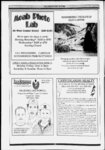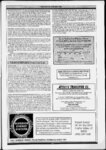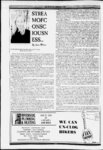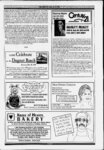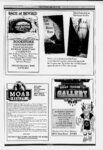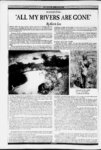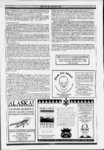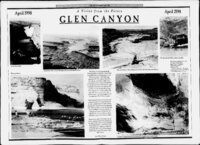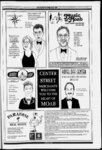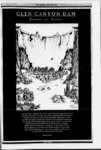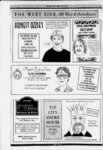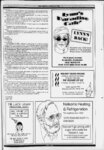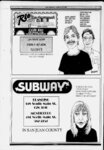| OCR Text |
Show time of settlement. Of how the Indians exchanged their land to the Mormons for "horses and beeves." She told me of Navajos coming to trade by crossing the Colorado River and walking over the Kaiparowits Plateau to Escalante. I read many stories about the country too. Indians were harassing settlers and stealing livestock in the southern and central parts of the state. Lands had been taken from the Indians so there was some justification for the marauding. The Mormons decided to take the offensive, and so began the Black Hawk War. A cavalry contingent was formed, and the small army tailed some Indians up the Paria, across the divide, and then down to a beautiful valley of the Escalante. (The party named it "Potato Valley" because of wild tubers growing there.) After following the Indians for many miles, the cavalrymen gave up and turned back and awaited their pay. In 1869 and again in 1871-7Major John Wesley Powell made adventurous and Green scientific trips down the and Colorado Rivers. Pbwell loved naming things and his names stuck: Cataract Canyon, Glen Canyon, the Henry Mountains the Dirty Devil River, the Escalante River, and the Kaiparowits Plateau. Then in 1871, Jacob Hamblin, the legendary Mormon Indian missionary got a job from Powell carrying supplies by packtrain to the mouth of the Dirty Devil to meet the river party's second boating party. The Hamblin party followed up the Paria and then down into Potato Valley by packtrain. Hamblin assumed the Escalante headwaters was the Dirty Devil River. So he descended the river for about 50 miles fighting quicksand much of the way. He too gave up and returned to Kanab as he hopelessly didn't know where he was. In the spring of 1875, the settlement of Escalante began with the arrival of men work parties. And the following year, the brethren brought their wives and families. And over the years, in working their lands, they accomplished many of their goals. Escalante still stands. Well, that's part of the human history, and our folk left us a great heritage and turned over their lands to a new generation. The land's care is now in our charge. AROUND THE BEND A GA IN 2, SAN JUAN COUNTY By Ken Sleight GLEN CANYON DAM - A CONTINUING TRAGEDY "GIVE NATURE A LITTLE TIME'' The construction of Glen Canyon Dam was a great tragedy, a violent act that should never have happened. So unnatural, unjust, immoral, destructive. It wasn't necessary to bury the thousands of ancient antiquities and ruins, to bury the many beautiful canyons and natural features, to destroy the very thing so many people hold of such great value, and to prevent peoples everywhere from experiencing them. Having spent so much time in the canyons, I deeply feel the atrocities that have been committed. To me and to millions of others the great inundation was another holocaust. And in contrasting this period with the ages before it, this was the crudest act of all. Even "manifest destiny" left its impacts, but none were as violent or total as this one. I look back at the region's history. While our pioneer ancestors endured hard times in "taming the land" and "making the desert blossom like a rose," they in so doing closely adapted themselves to the land and left their heritage in so doing. Today, we live our lives enmeshed with that of our ancestors as well as with our contemporaries. We often find the old days and the old ways still of great value and very satisfying. We like it the way it was. I Destroying the Legacy And look at what we have done! We've squandered the lands and the rivers to which our ancestors were so dedicated. And when our own generation passes what then do we have to pass on to our kids and their kids and the many future generations to come? During my boating years on the Colorado River I often camped at Music Temple, or slightly upstream from Hidden Passage, and for two nights at Forbidding Canyon so that we could spend the full day hiking to Rainbow Bridge. Favorite places all. And 1 watched it all go. There came the destructive and rising waters in 1963. Devastation all about. The waters were rising fast, now to the Hole-in-th- e Rock gully where the Mormons had crossed the Colorado River in 1879 on their six month journey to Bluff. I camped for the night at the Escalante. I was very morose and angry that night; things would never be the same again. "Lake Foul" was too much. There was so much destroyed, and the river quit flowing. I had a good talk with myself most of the night. Next morning we hiked to the Cathedral in the Desert. Then I announced to my intrepid group that I'd be moving my operations to the isolated town of Escalante, an historic, small, dusty town that lay upstream some one hundred miles as the bends of the river go. "Upstream is pure wilderness!" Once I had announced it, I felt much better. I moved my family to Escalante the next spring. The glorious days I spent in Glen and Escalante Canyons will ever be with me. Living and traveling through this country wasn't always easy, but it was a spiritual and supportive world to me. If heaven is like that (supposing we have the fortune of reaching heaven), we're in luck. Abbey and I used to play that game of postmortem. What could have been done to prevent the dam? And then we asked, what can be done now to remove it? His answer was the Monkey Wrench Gang. Required reading! But a postmortem is necessary. The role of politics played a great part in that and honest leaders that truly thought tragedy. Though there were many their actions would indeed benefit society, I believe there were a few leaders political that permitted the disaster. prostitutes and It would be hoped that in our democratic society our leaders would rule mildly and beneficially for the good of all, but we do not have that assurance. Our leaders are often caught up in forces, dictated by wealth and power, that restrict their choices and often make them do unjust acts. Glen Canyon's demise was such an act. There was no justice. Back then, we had blit little real strength. Our small inarticulate Friends of Glen Canyon group and the pleas of river outfitters had no g effect. The letters of citizens had no effect. The leaders arrogantly took advantage of our weakness with their superior political might. Yet... we were close to Remembering My Pioneer Heritage As a history buff. I've tried to compensate for that "yearning-fbr-the-pas- t" feeling that continually follows me. I do it by tracing my heritage back in time. It's a great joy to follow the same old horse trails they rode, to boat down the same rivers they rowed, and to search out my kins' grave sites lost out there in the desert somewhere. Then I get an inkling of the heritage our ancestors left us. Of all of the canyons, the Glen Canyon and the Escalante Canyon played such an and I felt inspiring part. Before the great inundation, these canyons were heaven-lik- e wilderness and beauty there. And that beauty stuck with me. There are beautiful meandering rivers, rock cliffs, cliff dwellings, monoliths, fossils, dinosaur tracks, petrified trees, deep winding canyons, inaccessible mesas, sand dunes, lakes and ponds, burial mounds, and rock writings that make up the canyons. There arc upwarps and downwarps, anticlines and monoclines. There are thousands of colored erosional forms and many other forms of beauty. And upstream at its source, there is The Hells Backbone, a sharp ridge with a bridge built over a crevice in the rock. The precipitous walls on both sides drop hundreds of feet to the floor below. Death Hollow on one side and another deep canyon on the other. For a number of years, my head wrangler Reeves Baker, as a kid, carried mail and provisions by pack horse from Escalante to Boulder. He left a beautiful heritage. I remember, years ago. Grandma telling me stories of the colonizing experiences she had in Escalante and how beautiful she thought the country was. She spoke of how hard it was to survive and to make a living. She talked of her own kin and friends who came to settle that land. Old family names the Spencers, the Allens, the Lees, the Roundys, the Woolseys, and a host of other families she vividly recalled. She told me of the Indians that frequented the area. Of those that lived there at the ' well-meani- ng sell-ou- ts heart-rendin- NINE OUT OF TEN PEOPLE AGREE: Terry & John are two of the friendliest people on the planet. 702 S. Main, Moab 259-573- There is 1 a 99.99999 probability that if you come by the store, they will not hit you or HARDWARE SPORTS RECREATION drive you from the premises in tears. UNHEARD OF IN All in one store AMERICA IN 1998? Not here. sssssm am wmmmm w WE aims?- iaiaiauiUs&M I 3 A' if' Tt! rnnna |





